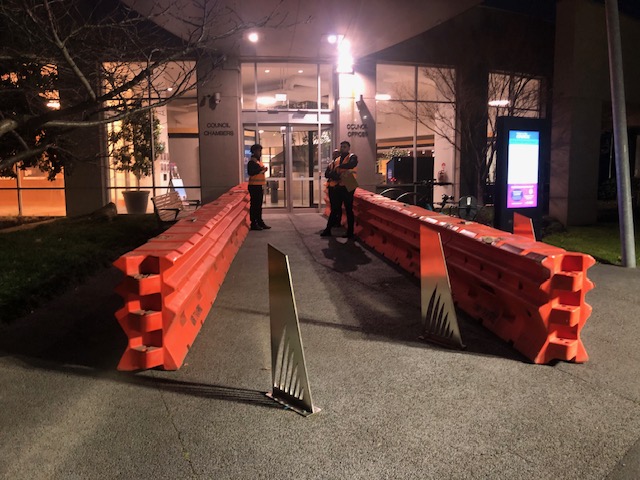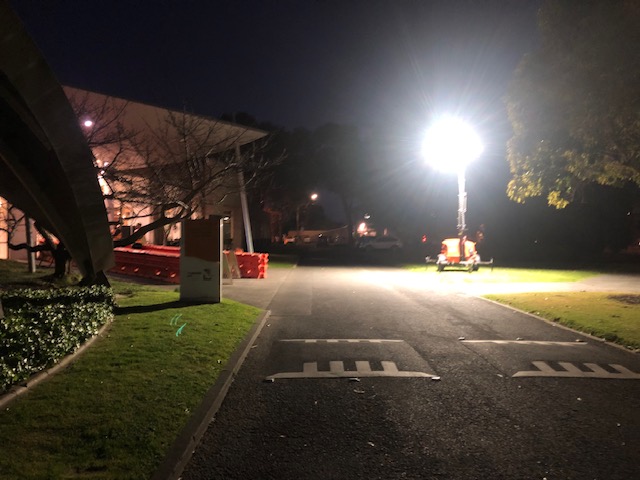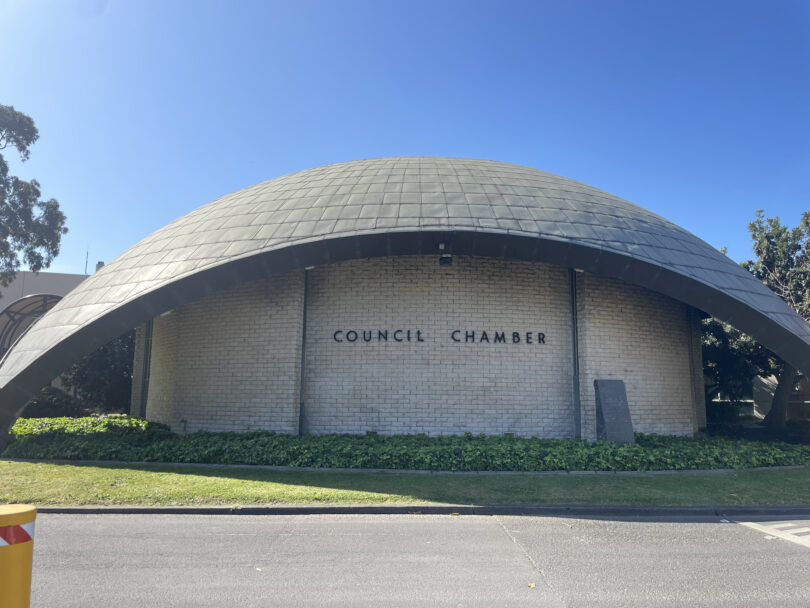By: Tiarna Condren, Jack O’Shea-Ayers, Declan Bailey, Eliza Freeman.
This year has seen a meteoric rise in the number of local councils deciding to postpone or cancel council meetings or move them online.
The Municipal Association of Victoria (MAV) has confirmed that at least 15 different councils across Victoria have faced disruptions, forcing them to add security personnel, ticket meetings or cancel meetings entirely for the safety of the councillors.
But in the suburbs of Melbourne’s inner west, questions arise around the prevalence of My Place in their communities and whether the councils are using these disruptions to hide from valid criticism.
The fault for many of these disruptions has rightly been directed at the fringe conspiracy group My Place, whose members have been at the centre of the council disruptions to take place this year.
The first such incident occurred back in January when 140 members of the Yarra Valley chapter of the group forced a Yarra Ranges council meeting to be abandoned after only 10 minutes. In April the council decided to close public access to their meetings until June due to an “increasing pattern of verbal abuse, intimidation and anti-social behaviour,” according to Yarra Ranges Mayor Jim Child.

My Place claims to be an organisation aimed at “putting ‘unity’ back into community,” with farmers markets, food drives and community events being a staple of the various Facebook groups its members organise in. And this is what drew Anastasia Kalaitzidis, a local of Brimbank and a My Place member.
“I am a member of that group, My Place Vic group, we’re not into violence, we just want to be heard,” she said at a Brimbank council meeting after it had been postponed.
“We’re just a bunch of people who have created our own little community, our own little network. Where’s the democracy? We’re here to talk.”
But to characterise them as a group that is just “here to talk” and make their communities better would not be telling the whole story.
The other major disruption of councils with My Place at the centre occurred in April when members of My Place, alongside members of other fringe groups like Reignite Democracy Australia, protested a City of Monash council meeting over a drag story time event planned for a few weeks later.
In the recorded live stream of the meeting, the crowd can be heard booing and yelling at councillors and Mayor Tina Samardzija as she read out the plans for the event. Councillors were called “paedophiles” and accused of “promoting sex to children”.
While the events at the City of Monash could be cause for concern, other inner-western councils have employed similar tactics of precaution, with some residents feeling it is a gross exaggeration.
Despite having no direct disruptions, Hobsons Bay City Council have employed security guards, installed floodlights, and are checking IDs as residents enter the building.
Avid council meeting attendees Phillip and Kaylene O’Shea said the events at Monash are “totally irrelevant to what’s happening in Hobsons Bay”.
“There hasn’t been the slightest hint of that in Hobsons Bay, none at all. So to say, oh, it happened at Monash, therefore we should take precautions at Hobsons Bay. It’s just rubbish,” they said.
“There has never been the slightest hint of an unruly council meeting.”
After denying an interview, Hobsons Bay Mayor Tony Briffa responded, “we regularly review and refine our security processes and procedures to ensure the safety and wellbeing of our Councillors, employees and community.”
Residents have become increasingly concerned about where the funds for these security measures are coming from, claiming it must be “costing a fortune” to have the bollards and flood lights run by a diesel generator.
Kaylene O’Shea said there is a “lack of transparency on multiple levels”, and despite asking the council how much it costs, she was not given an answer and was instead directed to the CEO reports where there is no direct financial breakdown.
The couple argue that the council are using these disruptions to hide from criticism and conversation, claiming the council has a history of trying to ignore residents.
Mayor Tony Briffa is an administrator of the Altona & Seaholme Residents 3018(& Altona Meadows, Altona North & Brooklyn) Facebook page, where local residents can voice opinions and share community events.
Phillip O’Shea said a few months ago, when there was opposition to parking metres, the page was “running hot” with opinions and, “people were just getting chucked off the website left, right, and centre”.
“We know literally dozens of people who have been blocked.”
Following this upheaval, community members created a similar Facebook page, alleging they were blocked from Altona & Seaholme Residents 3018 for voicing concerns about the current council and their actions.

One resident wrote, “I hope people realise the conflict of interest when a councillor who administers a community page controls the discourse and blocks people whose opinions they don’t like and disagree with.”
Overall resident satisfaction with the council appears divided, with the recent disruptions representing only a fraction of a larger issue.
About one third of questions submitted to Hobsons Bay council last month were concerned with communications between council and its public.
Far-right extremist groups and organisations like My Place have a long-standing history with councils and disrupting the processes, to their detriment and betterment.
While justified fear and paranoia are to be expected in these scenarios, the relevance of their threats to all proceedings is questionable and not necessarily applicable to all councils.
Unmasking the Culprits: Who’s Behind the Targeting of Western Local Councils? Explainer
In recent months, suburbs of West Melbourne have been marred by the troubling presence of far-right groups, casting a shadow over local democracy and raising serious concerns about the safety of public spaces.
Among these groups, the My Place network has emerged as a prominent organisation, making headlines for its disruptive tactics, and garnering notoriety for its brazen attempts to silence democratic proceedings.
The repercussions of their actions have been felt across Melbourne’s inner west, where council meetings have been closed or made harder to access by the public.
Operating with an agenda that is at odds with its principles of inclusivity and diversity, this group has brought its divisive ideology into the heart of local governance.
Associate Professor of Politics at Deakin University, Josh Roose said that since the pandemic, extremist groups have grown in numbers.
“We’ve seen a resurgence, a real growth of various movements. The freedom movement has evolved and morphed into a more, I suppose, fluid group consisting of a number of different actors who come together and converge,” he said.
“You’ve got My Place, who are often seen as a movement. They don’t identify openly as such, but it’s very clear from the dissemination of their material. You’ve got far-right actors, you’ve got a variety of religious groups.”
Map of My Place Cells/Chapters Across Victoria
Local Brimbank resident and My Place member Anastasia Kalaitzidis said she joined the group after regularly meeting with members for coffee in one of Brimbank’s local parks.
“I met all of these wonderful people because during the lockdown we used to catch up in the Brimbank park, just for a coffee, or go for a walk and we blossomed some friendships there,” she said.
After joining, Ms Kalaitzidis said conversations about their local councils evolved into the group’s goals and objectives.
“These governments have been doing this and this and well, let’s do something about it,” she said.
“There are quite a few in the group that know a lot about the councils. They just try and say, if you are the council, where is your coat of arms? And they don’t answer. We just want answers, they are corrupt.”
In an effort to address these troubling developments, the Victorian Parliament has initiated an inquiry into extremism in the state. The ‘Inquiry into Extremism in Victoria’ aims to delve into the rise of extremist groups, their activities, and their impact on local communities.
The inquiry provides valuable insights into the extent of far-right extremism in Victoria, outlining the various aspects of extremism including ideological motivations, recruitment strategies, and the implications for community safety.
This comprehensive resource has been instrumental in shedding light on the challenges posed by extremist groups in our state, with one of the key takeaways being the urgent need for proactive measures.
Professor Roose said that local councils in the western suburbs are doing the best with the resources they have available, but it isn’t sustainable.
“It’s not sustainable in the long term and it can feed into the narratives of an unaccountable government. But it’s also important to acknowledge that the councils are dealing with not just the peaceful protestors but people who are making threats, seeking to intimidate and to disrupt,” he said.
In response to these developments, the Victoria Police have increased their efforts to monitor and counteract the activities of extremist groups through monitoring of online networks and the use of artificial intelligence to predict their movements.
In recent years, Australian far-right groups have garnered unprecedented levels of public visibility and media attention.
These groups, though diverse in their ideologies, all often share an inherent hostility towards liberal democracy.
They encompass a wide range from the more “traditional” neo-Nazis and proto-fascists to the “new” radical right, focused on nationalism, anti-immigration, and the preservation of Western values, with mounting evidence of their infiltration into and influence on mainstream Australian society.
The recent targeting of local councils appears to be the latest manifestation of the ‘concerned citizens’ persona, increasingly embraced by the Australian far-right.
The inquiry indicates that members of far-right groups operating in Victoria adopt a focus on nationalism and national politics when entering discussions, with these groups being shown to favour local political areas, seeking to exploit local issues in order to be heard.
Professor Roose said, “what we’re seeing globally is a push to target what is considered the softer underbelly of democracy.”
This tactic is particularly seen in the US, where municipal councils, school boards, and other local grassroots levels of democracy are being targeted by far-right activists.
He said groups like My Place are taking this “straight out of the playbook of fringe actors in the US” by targeting their local councils.
The disruptive presence of far-right groups in Melbourne’s west underscores the pressing need for a concerted effort to safeguard democratic values and social cohesion of local councils.
While the My Place group and similar organisations may voice legitimate concerns, their tactics risk eroding the very foundations of Australia’s democratic system.
The ‘Inquiry into Extremism in Victoria’ serves as a crucial step in addressing this challenge, offering insights and recommendations to guide a response.

